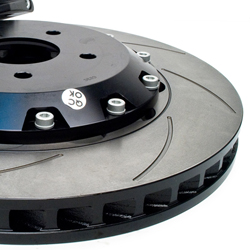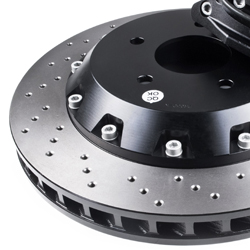Below we explain the difference between drilled and slotted discs.
 Slotted:
Slotted:
Slotted rotors offer improved bite (initial onset of braking) and slightly higher friction level than smooth rotors. Slots prevent reduction in friction due to pad outgassing or brake dust trapped between pads and rotors. Pad coefficient of friction is maintained over the lifetime of the pads, since slots shave away glaze formation and expose fresh pad surface each time brakes are applied. Slotted rotors are by far the number one choice for cars used in competition or open track events. Disadvantages include slightly reduced pad life, some low frequency rumble and pedal flutter when braking hard from high speeds.
 Drilled:
Drilled:
Drilled rotors offer slightly more bite and friction than slotted rotors. As with slotted rotors, pad coefficient of friction remains consistent over their lifetime. Wet bite is improved over plain and slotted rotors, so these may be the best choice for areas with heavy rainfall. Weight is reduced by about 0.2 pounds per rotor, depending on size and drill pattern. Disadvantages include possible uneven rotor wear, typically concentric groove formation, although this is mostly an aesthetic concern. A major disadvantage is accelerated formation and spreading of cracks under racing conditions. For this reason, drilled rotors should be avoided for track cars, unless required by the rules. A common piece of misinformation is that they have lower performance than smooth rotors, due to reduced surface area and are for looks only. This is false.
